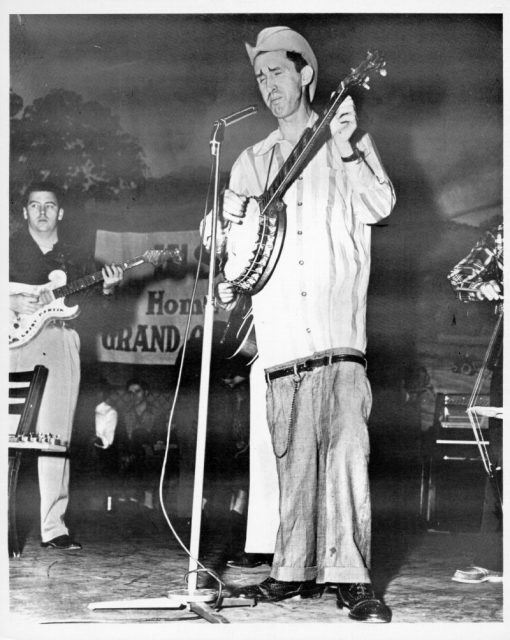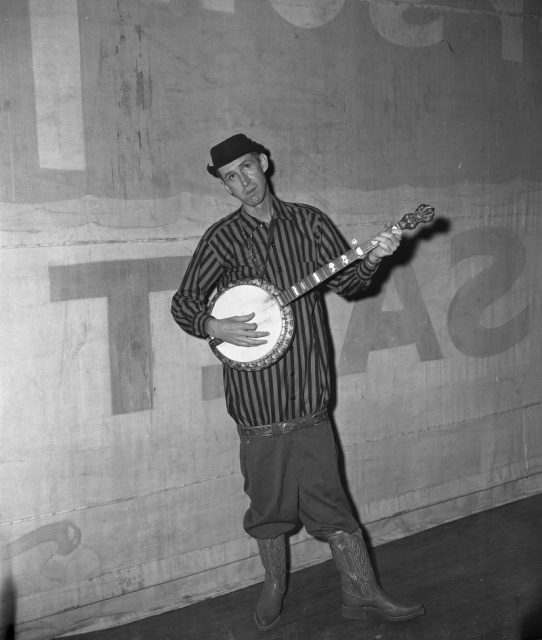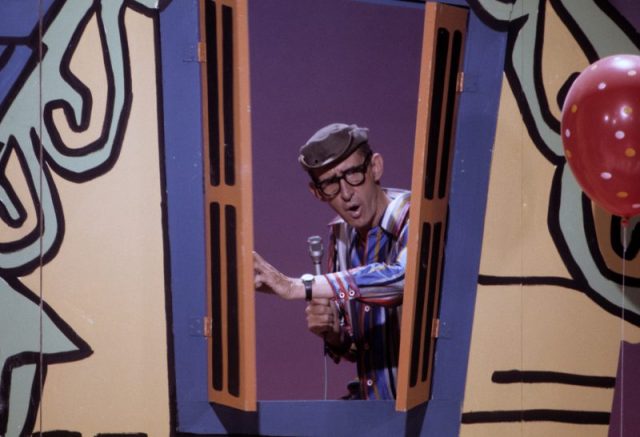The practice of wearing your jeans slung low may appear to be a modern phenomenon, but David “Stringbean” Akeman was wearing his pants around his knees as far back as the 1940s.
Today’s “saggers” are using the trend as a symbol of freedom and civil disobedience, and the craze is infuriating those in the right places, with some states in the U.S. enforcing fines and public nuisance orders for those who bare their underwear.
Stringbean Akeman was not in the business of civil disobedience but was an old-time country and bluegrass performer who used his tall stature and virtuoso banjo skills to delight and entertain the crowds as part of the Grand Ole Opry in Nashville and then later on the long-running American TV show Hee-Haw.

A child of the Great Depression, David Akeman grew up dirt poor in rural Kentucky. His family were a musical bunch, and Akeman made his first banjo from a shoebox and a piece of thread. When Akeman was twelve, he swapped two prize-winning chickens for his first proper banjo and quickly became prodigious at picking and the old “clawhammer” style of banjo playing.
Thanks to his skill, Akeman came to the attention of the likes of Asa Martin and Bill Monroe and can be heard on early recordings for both performers. It was during this formative part of Akeman’s career that he was taking part in a competition and the MC, forgetting his name, called him Stringbean because of his tall, lean physique, and the name stuck.
Rather than taking offence to the nickname, Akeman found it hilarious and started performing in a long nightshirt tucked into a pair of trousers that began at his knees; not only did this make him a memorable figure but also gave him a comedic gait that, along with his musicianship, quickly made him a favourite on the traditional country music circuit.

In the 1950s, as country music was moving into electric guitars and rhinestones, Stringbean carried on performing the old Bluegrass favorites and lived a simple life with his wife Estelle in their modest wooden cottage that had no central heating or indoor plumbing.
Stringbean and Estelle were by no means rich when compared to other performers of the day, but their humble lodgings were a personal choice. Both had grown up during the Depression, and both had grown accustomed to living a simple, frugal lifestyle.
The Depression had such a profound effect on Stringbean that he refused to have a bank account and was known to carry a large wad of cash in his overalls. It was an open secret that Stringbean kept his life savings stashed somewhere in his modest abode — Estelle could be overheard lamenting as much to her friends backstage at the Opry.

What happened next was to change the face of country music and indeed the entire Nashville way of life forever.
While Stringbean and Estelle were at the Opry one fateful Saturday night, two men broke into their cottage in the hope of finding the thousands that Stringbean was rumored to have stashed there. The men in their early twenties were from the wrong side of the tracks, the new face of decline in Nashville, and had been tipped off about the loot through a series of Chinese whispers.
Upon finding nothing but a handful of documents, a chainsaw, and a few guns, the men decided to lay in wait for Stringbean to get home.

When Stringbean and Estelle arrived home from the Opry that night, Stringbean noticed something wasn’t at the cottage and went in with his gun drawn. Stringbean got into a scuffle with Doug Brown who had sprung at him from behind the door. John Brown then shot Stringbean at point blank range, killing him instantly. Estelle, upon hearing the gunshots, tried to get back to the car to go fetch help, but John Brown caught up with her and shot her in the head as she ran away.
It didn’t take long for the police to catch the Brown cousins and they were sentenced to two consecutive life sentences. Doug Brown died in prison in 2003, but John Brown was released on parole in 2014 based on his good behavior and church work.
https://www.youtube.com/watch?v=_-hnfLRpimw
The brutal deaths of Stringbean and Estelle have been likened to the deaths of Buddy Holly and Sharon Tate in the effect they had on the wider community. Their deaths marked the end of a way of life in Nashville. Country music stars, no longer feeling safe, moved from living in the community to living behind electric fences and security guards.
Read another story from us: Steamy Life and Times of Diana Dors – Britain’s Marilyn Monroe
Rumor has it that many years later, Stringbean’s stash was found behind the brickwork of the chimney of his cottage. The money that caused so much tragedy was ruined to the point of disuse by the ravages of time and nesting mice.
